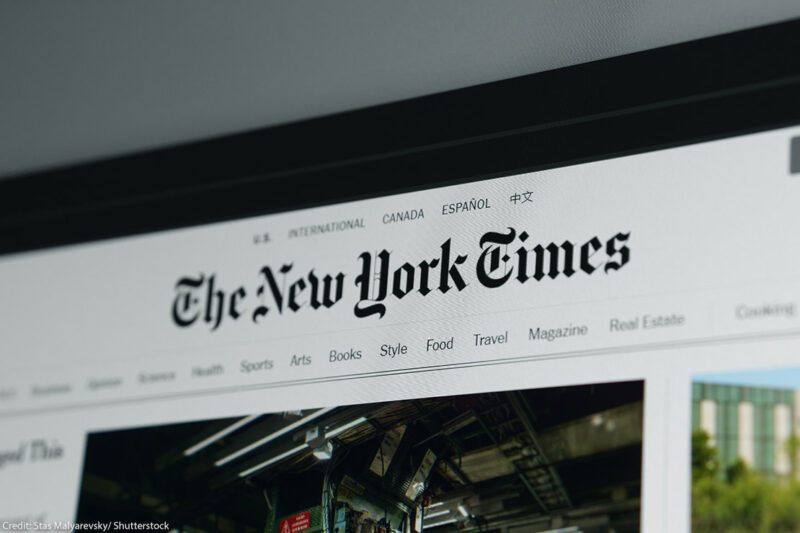60 Years Later: How a Civil Rights-Era Defamation Case Empowers the Press


The United States used to set the standard for press freedom. Now, it’s dropped its status as a worldwide leader, according to .
President Donald Trump has spearheaded a in the United States, filing three lawsuits against news companies such as ABC, CBS, and the Des Moines Register in the past few months alone. The president’s litigious approach to the press challenges long-standing legal protection for journalists under a landmark Supreme Court case from 1964 New York Times v. Sullivan.
The ruling originally protected The New York Times against expensive defamation lawsuits brought by southern government officials during the Civil Rights Movement. Since then, the case has become a crucial precedent for press freedom. It has served to protect journalists who speak truth to power, and has allowed news organizations to publish landmark stories, like the Washington Post’s Watergate investigation, as well as reporting on corporate malfeasance by tobacco and petrochemical companies among others, without fear of reprisal.
In the first installment of “Press in Peril,” an Ířşě±¬ÁĎ blog series on free press, we explore arguably the most important case for press freedom.
Civil Rights Roots
New York Times v. Sullivan stems from an advertisement that ran in The New York Times during the Civil Rights Movement. Sponsored by the Committee to Defend Martin Luther King, the advertisement accused officials in Montogomery, Alabama and other southern states of inflicting violence on civil rights protestors. The advertisement contained several factual inaccuracies irrelevant to the substance of the accusations, including incorrect names of songs protestors had sung on Alabama’s capitol steps and the false claim that Montgomery officials had padlocked the dining hall of Alabama State College.
Public officials in Alabama did not take kindly to the advertisement's criticism. Although the advertisement did not mention any officials by name, the commissioner of the Montgomery Police Department, L.B. Sullivan, sued The New York Times for damages, claiming that the advertisement defamed, or made false statements against, him and other Montogomery officials. Alabama court ruled that The New York Times was at fault, ordering the paper to pay $500,000 to Sullivan.
In mid-century America, defamation cases against the press were not uncommon. Public officials in the South often used such cases strategically against the press to damage reputations and silence criticism. As news outlets sent reporters to cover civil rights protests, they often faced hostility, physical attacks, civil libel suits, and even criminal libel prosecutions for their reporting.
Apart from Sullivan, more than 10 other Alabama officials sued The New York Times for defamation stemming from the same advertisement. As a result, The New York Times faced millions of dollars in expected damages. Considering the newspaper’s small presence in the South and the threat of bankruptcy if they had to pay such high damages, the newspaper ordered all of its reporters to leave Alabama until the suit was settled. Fearing the same fate as the New York Times, contemplated doing the same.
A Win for Free Speech and Press Freedom
The Supreme Court ruled unanimously in favor of The New York Times in 1964. The court reasoned that Sullivan’s status as a public official required a new standard of review to avoid censorship of the press when covering stories of public interest.
Before this historic ruling, state law largely governed defamation cases. But the Supreme Court held that, to provide breathing space for true speech and ensure that public debate remains uninhibited, the First Amendment protects reporting on public officials and public figures even when it contains inaccuracies. The Supreme Court held that defamation liability could be imposed only when the speaker knows the speech is false or intentionally disregarded a high risk of material inaccuracy. This became known as the actual malice standard. As the Supreme Court recognized, if powerful people could sue the media every time they made a mistake or said something critical, a robust media landscape would cease to exist. Most outlets cannot afford lengthy litigation or damages, and the high price would scare them away from investigative or critical reporting.

Free Speech

Free Speech
By requiring public officials and public figures to prove actual malice, the ruling made it harder to punish newspapers for good faith reporting on controversial issues. This emboldened a new generation of journalists, who could now investigate public officials across the country without fear of retaliation for their reporting.
Sullivan Expands to Public Figures
Sullivan established robust First Amendment protections for speech about public officials, leaving speech about powerful and prominent individuals outside of government vulnerable to defamation suits.
The Supreme Court addressed this discrepancy and created a broader category of “public figures” in 1967 to include people with a role of prominence, fame, or notoriety in society. Since
then, courts have applied the actual malice standard to defamation cases against media outlets brought by A-list celebrities, corporate leaders, and activists. For example, rapper Drake sued Universal Music Group in January, alleging the song “Not Like Us” by Kendrick Lamar defamed Drake — but as a public figure, he will need to prove actual malice, a high legal bar, to win.
Although deeply embedded in American culture, Sullivan has still generated controversy. In 2021, Supreme Court Justices Clarence Thomas and Neil Gorsuch made headlines when they wrote separate dissents to the majority’s decision not to hear a defamation case, Berisha v. Lawson. The case surrounded a defamation lawsuit filed by Shkelzen Berisha, son of a well-known Albanian politician, against the author of “Arms and Dudes,” a book that was popularized by the 2016 film “War Dogs.” Berisha alleged the author falsely associated him with the Albanian mafia.
Disagreeing with the lower courts’ application of Sullivan and the precedent as a whole, Thomas and Gorsuch called for the case to be reviewed and overturned. By calling for Sullivan to be reviewed, Thomas and Gorsuch challenged decades of precedent and alarmed journalists and First Amendment experts across the country.
New York Times v. Sullivan Faces Renewed Challenge
In his latest attack against the press, Trump is now testing the limits of defamation law by suing media organizations such as ABC, CBS, and more
Trump sued ABC and anchor George Stephanopoulos for stating on-air that Trump was liable for rape, arguing that he had instead been found liable for sexual abuse. ABC News and Stephanopoulos reached a settlement for 15 million dollars and an issuance of an editor’s note of regret rather than going to trial.
Despite recent challenges in the Supreme Court and by the current presidential administration, New York Times v. Sullivan remains a bedrock case for freedom of the press in the United States 60 years later. The higher standard that applies to public officials and public figures remains essential to the First Amendment, keeping speech on matters of public concern uninhibited and enabling the press to seek truth to the best of their ability. The actual malice standard is particularly crucial as a new wave of independent journalists, most of whom lack funds for legal defense, call out public officials online and pursue stories that shine a light on government abuses of power.
The Ířşě±¬ÁĎ is committed to fighting for reporters’ right to hold those in power accountable. Through “Press in Peril,” our ongoing series, we’re highlighting the challenges facing the press in a democracy under pressure.


